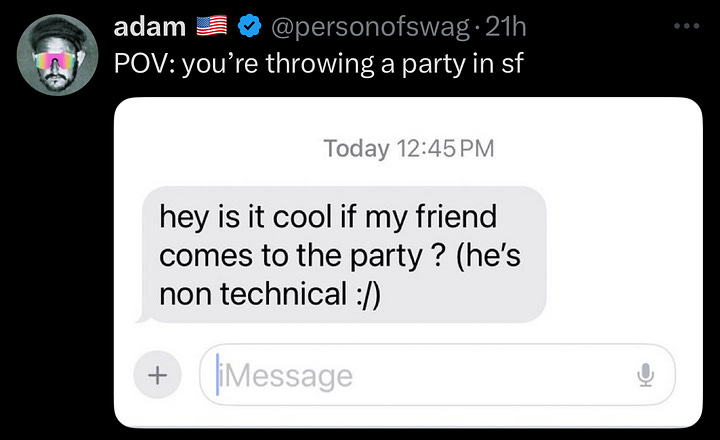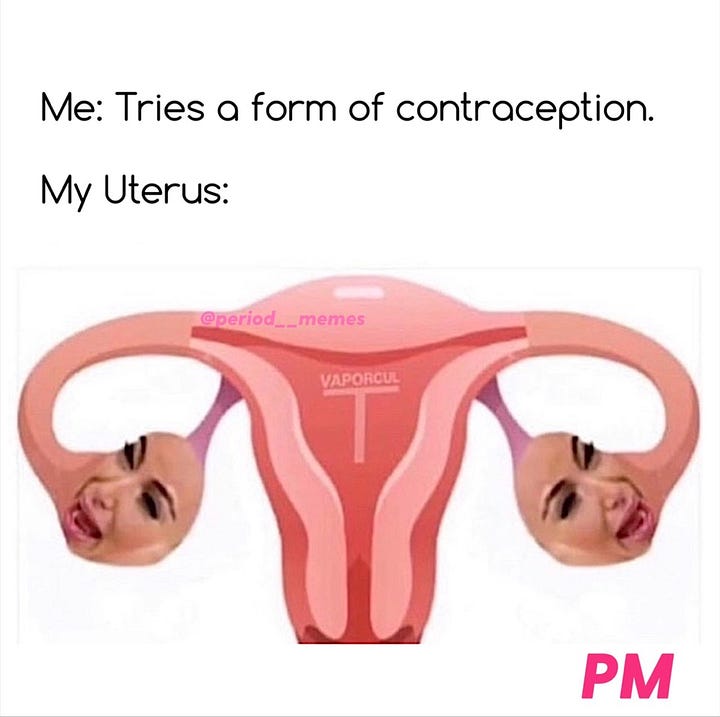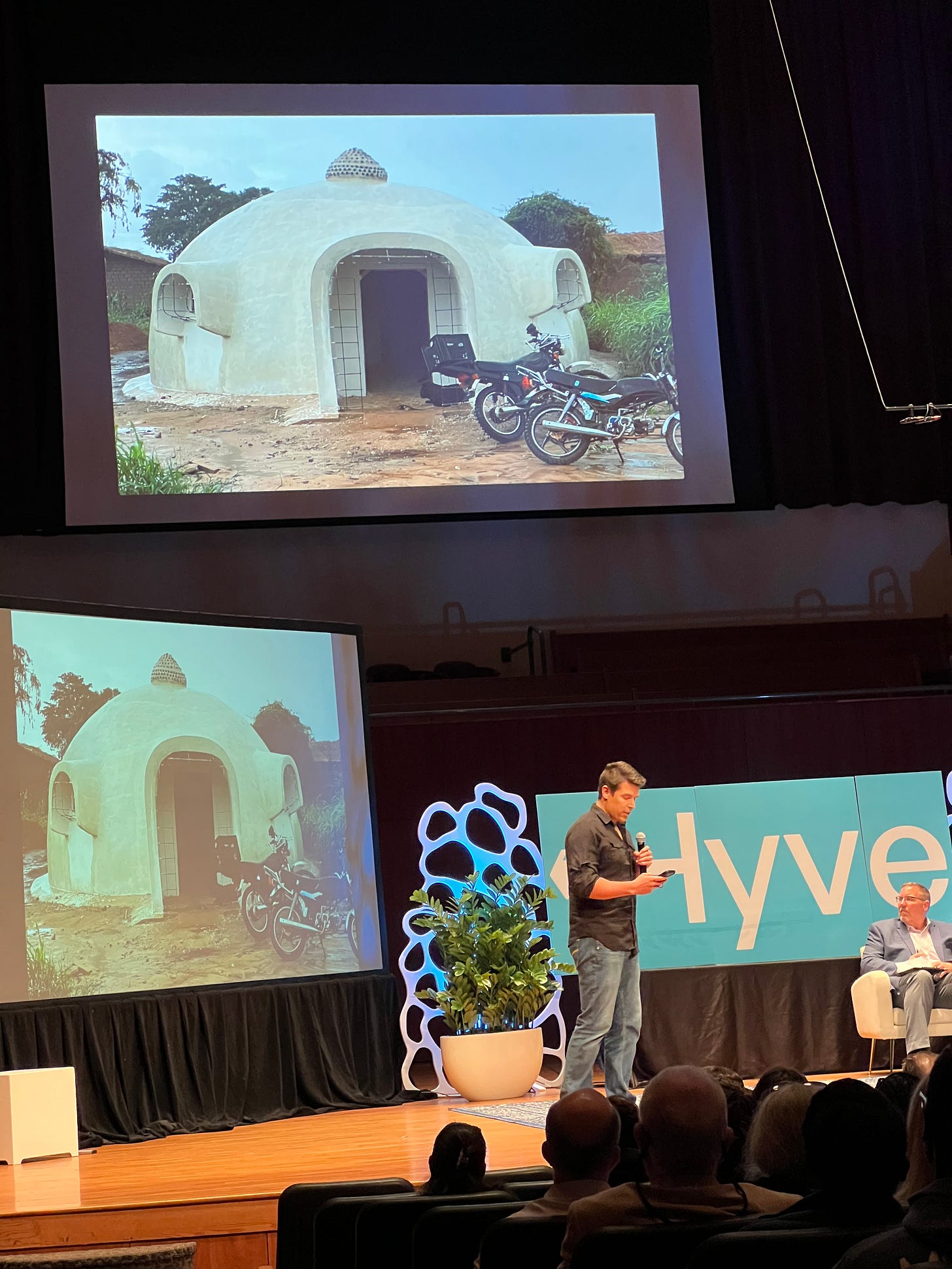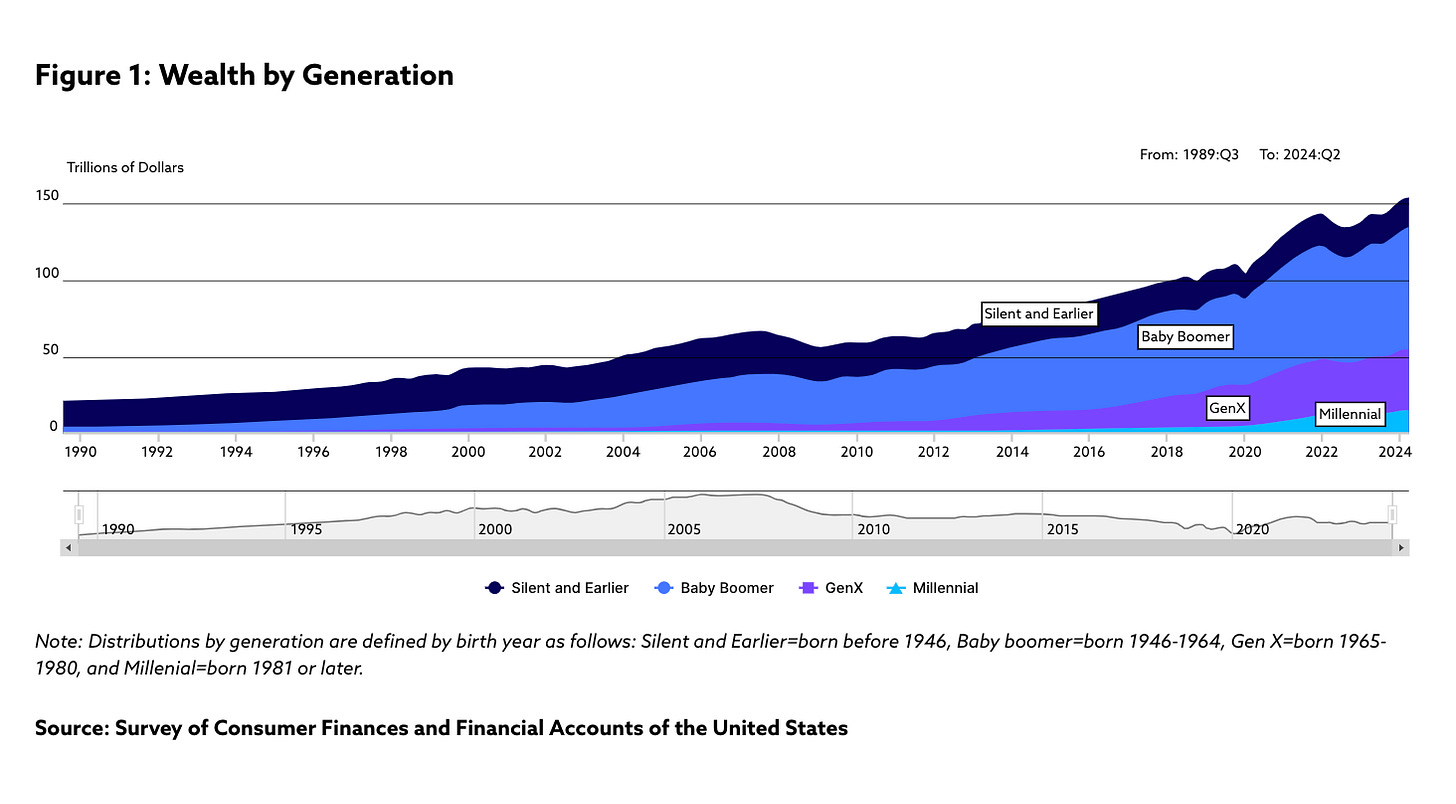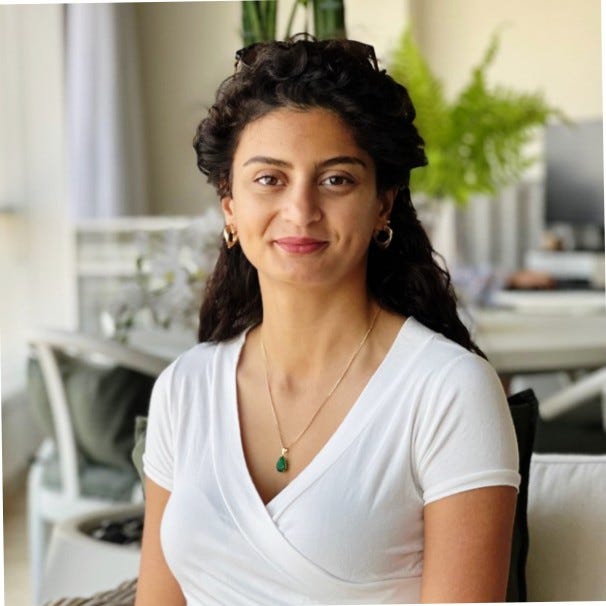Building Through Chaos. Gen Z’s Two Wallets. Elvie’s Brutal Exit.
When the world is burning, the trust is broken, and the inheritance is missing, founders builds anyway.
Founder Journey: Know Your Why
I meet a lot of rad people. And by rad, I mean EXTREMELY RADical. As in inconvenient principle. Dangerously convicted. The type of people whose “why” has teeth.
I’ve met high school teachers with war in their eyes, ready to throw hands with the city council over milkweed and monarch butterflies. I’ve seen Finnish grammas knitting sweaters for frontline soldiers like they were patching up their own sons. Journalists who break stories in places where stories break people. Founders who’ve pawned their furniture and sense of safety to build things no one asked them to build—but needed anyway.
This weekend was more of that. I stumbled across Andrew at a social entrepreneurship thing. One of those too-cool-to-be-mainstream conventions with name badges and social impact as a shared love language. His story was...loud, in a quiet way. He sold everything. I mean everything. And not in the sexy minimalist “everything I own fits in a backpack” way. More like: he watched his stuff disappear so a village could stop burning.
Literally.
Turns out, the homes in this village get torched during terror raids. Bullet-riddled. Eaten by termites. Reduced to rubble on a recurring basis. And Andrew decided to do something about it. So he built homes. Fireproof, bulletproof, termite-proof. Which is kind of like saying “emotion-proof” but for architecture. These homes stay. And so does he.
He lives his cause the way monks live in silence. Like it’s the only thing that makes sense. Like quitting would be a betrayal of physics.
And maybe that’s what separates rad people from the rest of us. We build reasons not to care. They build hope.
In today’s newsletter: Why Gen Z’s inheritance won’t save your startup // Trust is now transactional, not tribal // Australia bets big on women’s health // Femtech consolidation heats up with Willow’s Elvie acquisition // A SLIM new era for injectables // The dual economies within Gen Z wellness culture // Meet Noor Jaber, the founder building sexual health tech in conflict zones
Gen Z DeCode: The Illusion of Inheritance- The Great Wealth Transfer
Let’s talk about inheritance. Or rather, the illusion of it.
Gen Z is allegedly the heir to a $124 trillion fortune. That’s the big headline. The truth? Most of us won’t see a dime until later, if at all. So, building products around the idea that Gen Z will someday be rich is not just premature but a bit naive.
TLDR:
The Great Wealth Transfer is real in the aggregate. Millennials and Gen Z combined still hold a fraction of national wealth, while Boomers and the Silent Generation continue to dominate the asset pool. This wealth transfer is not democratized, not liquid, and at least a decade away for the average Gen Zer. For the majority of Gen Z, financial security isn’t coming from a will or a trust fund rather, it’s being hacked together paycheck to paycheck, side hustle to side hustle. This is the generation of financial tension. You have your digitally native, health-aware, but spending more than they save. That’s the opportunity.
Serve the "Now"
Bank of America projects Gen Z spending to hit $12.6T by 2030. But as previously mentioned, Gen Z is already spending more than they save. Their spending-to-savings ratio is 1.93, which is the highest of any generation.
Meanwhile, the CFA Institute and Financial Times reports suggest that any real inheritance isn’t coming until midlife, if ever. The wealth is there, but it’s locked up in the top 10%, aging parents, and rising healthcare costs.
Don’t build for a fantasy. Build for the financial realities. That means:
Flexible payment models
Insurance integration
Peer-led education platforms
In other words, be accessible, and not just aspirational.
There is No Middle Class Safety Net: The Two Gen Zs
The Financial Times and CFA remind us that 80% of wealth is concentrated in 20% of households. For the rest? It’s vibes and Venmo. BofA also reports that 52% of Gen Z says they can’t afford the life they want, despite high educational attainment and wage growth.
Not to sound dramatic, but I think we’re asking the wrong question. It’s not “How does Gen Z compare to Boomers or Millennials?” It’s actually, what’s happening within Gen Z? The meaningful segmentation is by liquidity, volatility, and access perception.
Because honestly, the more urgent divide is internal.
Hard data is still catching up, but if you look at spending patterns, wellness access, and the tiering of every DTC brand on Instagram right now, it’s clear that Gen Z is not one audience but rather two economies. Some have wealth. Some have TikTok financial advice and a Buy Now Pay Later cycle they can’t break.
Some are:
– Buying $300 Oura rings and syncing them with their hormone therapy
– Building second homes in Joshua Tree (you’ve seen the Pinterest boards)
– Egg freezing like it’s a wellness flex
Others are:
– Skipping dental appointments because of co-pays
– Crowdfunding their IUD removal
– Taking pics of one $7 matcha to post on different occasions
And somewhere in between lives what I’ve started calling the aspirational middle and not middle class by income, but middle by desire. They’re optimizing their health, not because it’s trendy, but because their life depends on it. Stability is a luxury.
Strategically, I think this matters a lot. If you’re building for Gen Z like they all share a wallet (or a savings account), good luck. Segment them by liquidity, volatility, and what they believe they deserve access to. That’s where things get interesting.
Democratize access without diluting aspiration. The vibe I’d say is to build for the ones living in chaos but reaching for control.
Transactional Trust
Gen Z isn’t buying your values. It’s more of a real-time stress test.
Let me explain.
You’ve probably seen pitch decks and brand manifestos proudly claiming alignment with Gen Z “values.” The issue? That framing assumes trust is still built top-down through statements, aesthetics, or performative alignment.
But for Gen Z, trust isn’t granted. It’s reverse-engineered.
They don’t follow brands. There’s trialing and auditing. Not blind “buy-ins.”
If you’ve earned their attention, it’s because you passed a micro-stress test. You delivered under pressure. You solved a real problem. A product that gets a slot in rotation doesn’t do so because of its mission, but more so because it performs.
This is especially true in categories like femtech and wellness, where the line between function and identity is blurred.
A cycle-tracking app isn’t just for tracking periods. It’s a tool for managing productivity in a workforce with no safety net.
We’re living in the aftermath of volatility: post-2008, post-2020, mid-climate collapse, mid-whatever-this-is-now. And we’re consuming in public.
Trust doesn’t decay slowly; rather, it vanishes instantly and visibly.
Reddit threads, TikTok callouts, Discord receipts. Everything is peer-validated and broadcast.
So what does this mean for operators?
This Gen Z version of trust has nothing to do with brand loyalty in the legacy sense. It’s storytelling woven into great performance across three dimensions:
Functional output (did this actually help?)
Symbolic capital (does this say something about me?)
Peer validation (have others pressure-tested it?)
And when I say performance, I mean: can your product hold up under real conditions?
Bodily autonomy is fundamentally about logistics, not ideology. People can't afford to miss work because of cramps, burnout, or emergency contraception when they have rent payments due.
Understanding your cycle goes beyond social media trends and serves as a practical necessity for managing daily life and productivity.
Products that break under pressure aren't impressive. Reliability is the minimum standard. Anti-fragility isn't exceptional, but we should expect it from the things we use.
This isn’t all survival and collapse. Gen Z still wants to aspire but just not in the old-school, status-signaling way. Products that help them simulate control. Tools for recovery and self-regulation. Identity tech. That’s why brands like Oura win. They do both: biofeedback and prestige. That’s why August works. It’s practical, expressive, and peer-approved.
So before you invest in another “mission-aligned” campaign, ask:
Can you actually hold up when it counts?
Can you survive being screen-shotted?
Can you scale without cracking?
This isn’t cynicism. More like adaptation.
Strategic Implications
Don’t over-index on projected purchasing poweroptimize for Gen Z’s current financial behaviors.
Bet on companies that de-risk access like fintech in healthcare, care collectives, and employer-sponsored wellness.
Invest in startups that turn Gen Z’s financial stress into sticky product market fit: cycle syncing for productivity, hormone literacy as career insurance, reproductive planning that isn’t elite.
Gen Z may eventually inherit the world, but they’re not waiting around. The real opportunity is building for the broke but brilliant. The cautious but committed. The generation that’s rich in ideas, poor in cash, and ready to disrupt everything.
Curation:
Australia commits $793M to women's health in federal budget (ABC): Govt to open 11 endo clinics, subsidize new contraceptives, expand menopause care.
Women's health startups raised $481M in 2023, just 2% of HC VC funding (Healthcare Brew): Market still undercapitalized despite rising demand for menopause and fertility solutions.
Queenslanders defy Cyclone Alfred, raise $1.7M for breast cancer research (Courier Mail): Mater Chicks in Pink Fun Run participants turn streets pink in statewide support.
Steppin app gamifies screen time to boost Gen Z movement habits (NYP): Users walk to unlock social media access as 80% report phone addiction.
21% of Women hit by long COVID, study reports: Hormones, menopause, and immune differences driving female chronic illness surge
Bacterial Vaginosis BV may be sexually transmitted, NIH study finds (Health)
SLIM Injectable contraceptive offers long-term birth control without surgery:
Scientists have developed a new long-acting injectable contraceptive that forms a solid implant inside your body after injection meaning no surgery is required. It’s called SLIM (Self-aggregating Long-acting Injectable Microcrystals) and was published this week in Nature Chemical Engineering. Early trials show it can deliver birth control for over 3 months in rats, with potential to scale. Imagine something more effective than Depo but self-administered, pain-minimized, and with no need for surgical insertion. It’s early, but if this tech evolves past animal trials, it could be a game changer for reproductive autonomy especially in low-access settings.
For context: there’s been a quiet wave of R&D into injectable and dissolvable contraceptives post-Roe, partly driven by pharma’s pivot to high-need, high-scale markets in women’s health. This one is still pre-human trials, but I wouldn’t be surprised if we see some VC movement here later this year.
Heart risk factors weigh 2x heavier on women, study finds (ACC)
Deal Sheet and Fundraising:
Uresta secures $3M to tackle bladder leaks with U.S. expansion
THENA Capital secures £27M first close for £50M MedTech fund (LSE): All-female GP team to invest in UK startups targeting women's health.
Caldera Medical acquires Ethicon's GYNECARE TVT product line, expanding women's health portfolio.
Willow acquires Elvie after $150mn-backed UK femtech startup enters administration (FT): Elvie, once hailed as the UK’s femtech breakout with $150M raised from names like Michael Spencer and BlackRock, has been acquired by US rival Willow after entering administration. This was ironically catalyzed by a 2023 patent infringement suit filed by Willow itself. The deal, which includes a full relocation of operations to California and likely job losses, underscores just how unforgiving the US market can be for hardware-led health startups lacking IP insulation. It’s a stark reminder that even design-forward, heavily capitalized brands aren’t immune to legal attrition, and signals a maturing femtech sector where consolidation, defensibility, and cross-border strategy will separate survival from collapse.
The Cycle:
I’m so excited to have sat down with Noor Jaber, as I’ve also lived in Lebanon working with women from the nonprofit angle, and it’s truly my honor to introduce her. Noor is a public health expert with a sharp mind for systems and a soft spot for stories that often go unheard. As the founder of Nawat Health, she’s creating a safe digital space where women can access sexual and reproductive care without shame, stigma, or surveillance. With a background spanning maternal health, gender equity, and behavior change across the MENA region and beyond, Noor blends regional insight with a global perspective while translating deep expertise into real, human impact.
Nilah: For those unfamiliar, can you share how Nawat started and what led you to build it?
Noor: I spent about 10 years working in the humanitarian sector—across Lebanon, Yemen, Sudan, Iraq, Libya—mostly focused on disaster management and working with refugee women around maternal and reproductive health. Across the region, I kept seeing the same things: shame around our bodies, stigma, and a lack of access.
Even as a teenager, I was passionate about women’s health. I ran anonymous Q&A sessions in a youth center where girls would drop their questions in a box. That stayed with me.
After COVID, when everything went digital, I thought—why not use tech to provide safe, anonymous access to information and care? I left my job at the Red Cross and launched Nawat in 2022. I’m trained in public health and recently became a certified sex counselor too. I wanted to bring all of that to the table.
Nilah: What are some of the unique challenges women in the region face when it comes to reproductive health?
Noor: Stigma is huge. You’re only “allowed” to ask certain questions after marriage—if at all. And even then, sexual health is often off-limits. There's also the issue of language. Most information out there is either clinical or rooted in risk—not in pleasure or agency.
What works in the West doesn’t always work here. We need culturally sensitive, evidence-based resources in Arabic—ones that affirm our identities and values, not shame them. And because many women fear being seen accessing these services, anonymity is critical.
Nilah: How has the ongoing conflict in the Middle East affected your work?
Noor: It’s been hard. One of our production studios turned into a shelter for displaced families, so we had to pause operations. At the same time, tech became a lifeline—displaced women could still access our content and talk to someone online.
It was a reminder that our work matters because of these circumstances. Still, there’s daily stress—investor reporting, managing a team, staying focused when the world is crumbling. But we keep going because the mission is real.
Nilah: What’s helped you stay grounded?
Noor: My team. Community. And trust. I really believe the right things happen at the right time. There's a phrase we use in Arabic that means “I surrender to the universe.” That keeps me grounded. Also—therapy. Lots of therapy.
Nilah: Are you noticing any new patterns in how women use the platform?
Noor: Definitely. We’re piloting our app in Lebanon, Yemen, Palestine, and Iraq. And what’s become clear is that women are digitally literate and eager for this information. We’ve heard things like, “Women in Yemen use Shein, of course they’ll use this.”
We need to stop viewing women in conflict zones as helpless. They have agency. They know what they want. Our job is to listen—and build accordingly.
Nilah: What’s the five-year vision for Nawat?
Noor: Expansion. What we’re building is adaptable—new languages, cultures, and countries. And we want to broaden our lens: reproductive health isn’t just about women—it’s about communities, partners, systems. We want to integrate that into the platform.
Nilah: What advice would you give to founders building in high-risk environments?
Noor: Stay agile. Things won’t go as planned—but that’s where creativity comes in. Conflicts force innovation. Look for the opportunity inside the chaos.
Nilah: And how has this journey changed you?
Noor: It’s reshaped how I view success. It's not just about scale or partnerships. It’s about learning. About showing up every day. I’ve had to be the CEO, the accountant, the tech lead—all of it.
Most of all, it’s taught me to let go of perfection and trust the process.
Nilah: How can people support Nawat?
Noor: Follow us on Instagram or reach out via our website. We’re looking for nonprofit and corporate partners—whether you want to subsidize care for women in need, or offer reproductive health support to your team. We’re ready to collaborate.
Hardy Har Har
